This is the most important question to ask yourself if you want to build a business, expand a business, or change a business. Or if you want to accomplish anything really… anything that requires more steps and more time that just making your bed in the morning.
What is a strategy?
According to the dictionary: a plan of action to achieve a major or overall aim or result
Strategy is essentially the bridge between where you are and your vision.
It’s also a narrative that takes the listener from how it is now through what it takes to get to the fulfillment of the plan: expanding, balding or changing the business or a project.
Unless it is clear for the listener that the actions listed in the narrative will surely get the speaker to the role, the likelihood of the goal to be accomplished is between zero and none. You can be both the speaker and the listener in this.
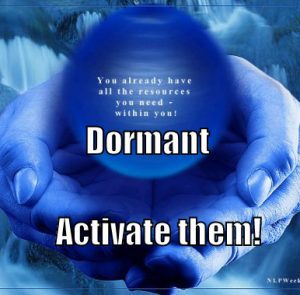 The capacity to create and execute a strategy need the working of some DNA capacities: the capacity to prepare: design and follow process, and the capacity to see each step with its consequence… accurately, not as a separate project but as part of the whole… so wide cone of vision, and being able to hold more than one thing in the mind… i.e. spinning plates.
The capacity to create and execute a strategy need the working of some DNA capacities: the capacity to prepare: design and follow process, and the capacity to see each step with its consequence… accurately, not as a separate project but as part of the whole… so wide cone of vision, and being able to hold more than one thing in the mind… i.e. spinning plates.
Lacking those capacities does not necessarily prevent you from doing projects or creating a business… if you are intelligent enough to have someone on your side to manage you (process) or coach you (strategy).
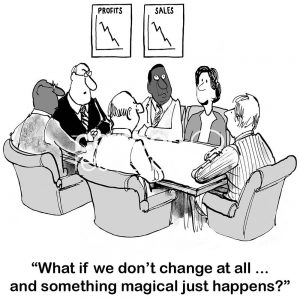 Most people without the necessary capacities never amount to much. Ultimately this is the reason for most failures… or non-starts: missing skills or missing capacities.
Most people without the necessary capacities never amount to much. Ultimately this is the reason for most failures… or non-starts: missing skills or missing capacities.
The issue of non-starters is very prevalent in my current clientele… Non-starters, usually, are people with magical thinking… because the missing capacities would provide the legs that are, with them, substituted with magic… or jumping. They can’t see that taking the correct small steps eventually will lead to what they want… So they don’t take any steps, or the steps they take are not correct for what they want.
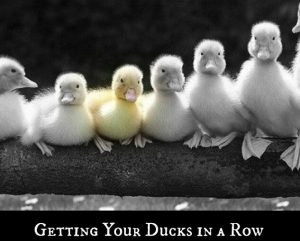 They want all their ducks in a row before they would start.
They want all their ducks in a row before they would start.
What got me through the non-starting phase is a meditation called ‘Remembering the Future’… I talk more about it in this article…
Next I am going to show some examples for creating a strategy and following it:
Example 1: I want to expand my business.
I have been teaching mostly spiritual stuff… and I am now interested id helping people who want to build a business, ready to build a business… or expand, change a business. Same principle.
I do have some business clients, but not enough to keep me busy.
So what is MY strategy?
I’ll continue writing my daily articles, but they are going to be geared to my desired audience. I’ll make sure that the title of the articles and the first 50 words make it clear that these are articles for people in business.
I’ll address the concerns of my desired clientele in the articles… emphasizing my uniqueness which is the invisible side of business… and helping people becoming the one who can…
I’ll schedule opportunities for people to talk to me to see if there is a match between what they want and what I can help them with.
I may offer free or almost free workshops… Especially the Brain Audit process I learned from one of my teachers.
A strategy is a lot like a business plan that makes others and you see that in fact you can produce what you intend to produce.
And yet very few people ever ask themselves: what is my strategy? answer and look, look and answer.
 Most people are stuck in tactics, and need someone’s help to actually develop a strategy.
Most people are stuck in tactics, and need someone’s help to actually develop a strategy.
But even to ask for help you need at least the minimum acceptable elements: where are you at now? what do you know. what are your resources? Time, money, skills? PEP Personality, Experience, Perspective.
When I decided to move from architecture to publishing I had no money, no skills, but I had time. I had experience as an architect, I had some experience in selling courses through volunteering in Landmark to call people on the phone, and I had experience writing. I had also designed and wrote small ads, albeit not very successfully. I didn’t have a car but I had a drivers license.
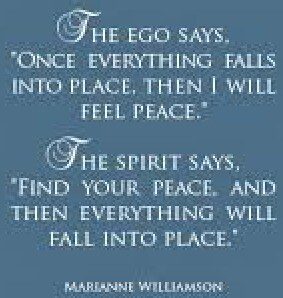 I decided to learn through offering my work for free. I started with printing… becoming a hand in a one-person print-shop for a month. I don’t know what I learned, but I felt more confident about the whole deal.
I decided to learn through offering my work for free. I started with printing… becoming a hand in a one-person print-shop for a month. I don’t know what I learned, but I felt more confident about the whole deal.
Then I spent a month in a typesetting outfit, small, family run.
And then I decided to ask for a similar job with a small local rag… but they advised me that they don’t need an assistant, but they always need an advertising sales person. I said: great, but I didn’t have a car.
They sent another sales person to train me for a day. She came, under her tutelage I sold ads in my local community… Next day when I went, the sales person came back and sold everyone sellable to beat me to it.
There was no sense in complaining, so I called the other local rag and told them the story. The owner met with me for lunch that same day, impressed with the seven ads I sold.
He lent me an old car, a gas card, and I was now a salesperson for the other magazine. This was in July. I sold ads. I participated in putting the magazine together, designing ads, even writing a few articles (dining reviews) and driving the magazines to stores that carried it for free.
By September I was allowed to do even more: redesign the cover. And in November I was fired… unexpectedly.
By that time I had enough advertising accounts that I could consider stealing them and starting my own magazine… and that is what I did. I became a publisher.
My strategy was to learn the ropes on the job using my existing skills, and work 10-14 hour days, seven days a week. I wasn’t paid by the hour, I was paid commission on the ads I sold… that was just enough to eat and pay rent and utilities.
That was fine with me. That continued, making just enough to stay in business, buy a decent camera, and get another beat-up car for $500. But after a couple of years the revenues made it worth my while.
I ran that magazine in print form for 11 years, and then in online form for another 15… when i moved over to my current occupation that you can also call publishing.
Without strategy the chances to do the right steps at the right time are dubious at best.
I am not a brilliant strategist but I am not clueless on one extreme, or have a cookie cutter strategy for everyone on the other.
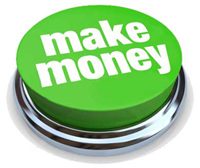 As in the past, I am willing to invest time to see if I can help, and if your PEP, resources, and end goal can be put together into a sound strategy… if you are one of the three categories of business I want to talk to:
As in the past, I am willing to invest time to see if I can help, and if your PEP, resources, and end goal can be put together into a sound strategy… if you are one of the three categories of business I want to talk to:
want to build a business,
expand a business, or
change a business
want some accomplishment, not necessarily a business. Can be in the area of health, education, or relationship.
The charge? None. But so that I know what’s under the hood, I request that you get your Starting Point Measurement done…
Why? I want to see if we ever worked together on your strategy and implementation, if I would enjoy working with you.
The Starting Point Measurements, for $20, give more information that is truthful than any questionnaire, or even personal call.
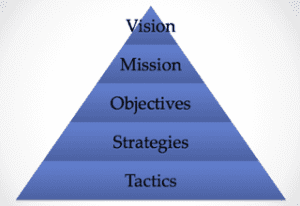 If I decide that the chances that I could enjoy working with you, I’ll invite you to a ‘strategy call’, that is really about strategy, not a disguised sales call.
If I decide that the chances that I could enjoy working with you, I’ll invite you to a ‘strategy call’, that is really about strategy, not a disguised sales call.
In fact you will have to sell me on working with you, even if your numbers in the Starting Point Measurements are fantastic.
OK, here is the link to buy your Starting Point Measurements. There is a question whether you wanted a business strategy session in the shopping cart.
Read the original article: What’s your strategy? Do you have one?
